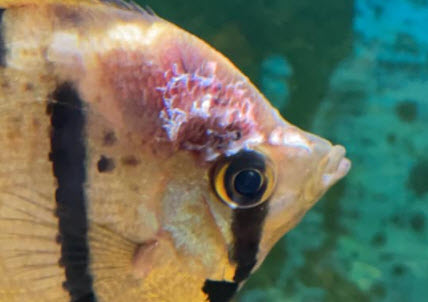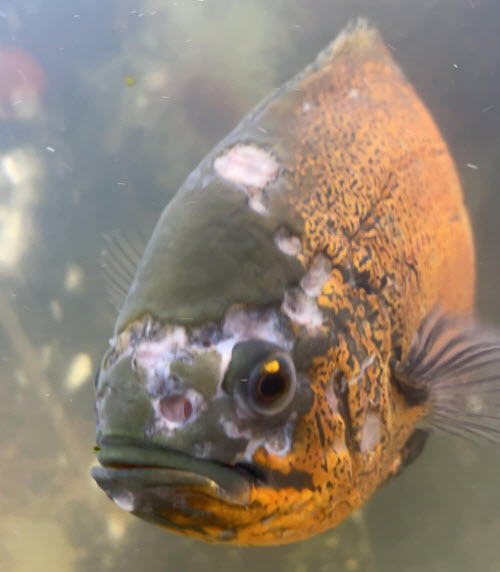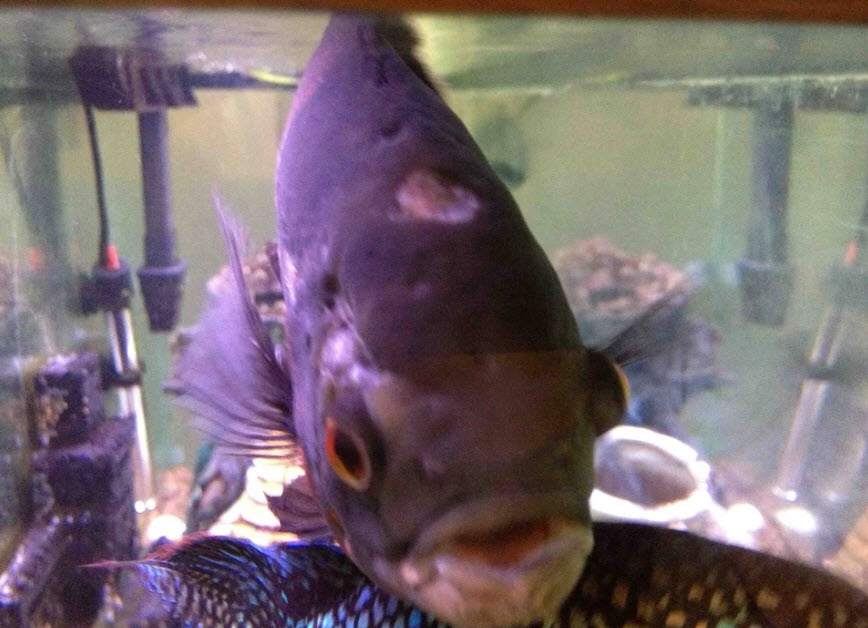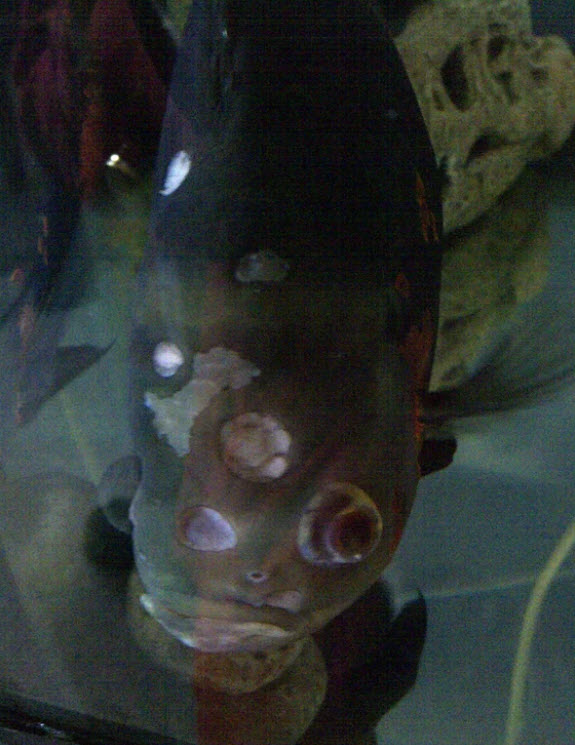
Many people (and many “expert’s” advice web pages) consider “hexamita” (technically the organism is spironucleus, not hexamita) as not only the primary cause of hole-in-the-head syndrome but also the name of the disease. This is simply incorrect. Water quality issues, NOT “internal parasites”, are by far the chief cause of hole in the head syndrome. Here is the analysis that shows the history of this myth:
The Science of “Hexamita” (Spironucleus)
Here is the correct scientific explanation of hexamita and spironucleus: “Spironucleus species: Economically-Important Fish Pathogens and Enigmatic Single-Celled Eukaryotes”, Catrin et al, 2011
“The diplomonads (suborder Diplomonadida, family Hexamitidae) are a group of aerotolerant anaerobic flagellates. Amongst the diplomonad genera are Hexamita, Octomitus, Giardia and Spironucleus. Species of Hexamita are mostly free-living organisms that reside in anaerobic water sediments, whereas the other taxa are almost exclusively parasites, which commonly occur in the intestinal tract of mammals, birds, reptiles, amphibians and fish.
Spironucleus species have attracted considerable attention from the veterinary and agricultural communities, due to the severe pathologies that they cause in companion and farmed animals.
Other Spironucleus spp. are of particular importance to aquaculture, as they can cause devastating outbreaks of systemic infections in both ornamental and food fish. In the ornamental fish industry, Spironucleus spp. cause severe infections in several economically important species including cichlids”.
When reading this paper, it is important to realize that the scientists are using the scientific term for “hexamita”, namely spironucleus. This terminology change was done in one of the those “tempest in a teapot” reclassifications that taxonomists are so fond of. The two are virtually identical organisms.

Note that there is a lot of confusion when it comes to hole-in-the-head syndrome. Spironucleus is often found in the intestines of fish with hole-in-the-head syndrome. It is there because the poor water conditions weakened the fish and allowed it to get a foothold. Poor water conditions also cause the hole-in-the-head. “Stringy white poop” and hole-in-the-head are thus often both present concurrently in a fish. Catrin et al referenced this point:
“Spironucleus vortens has been proposed as the causative agent of hole-in- the-head (HITH) disease, a common condition generally associated with poor husbandry. The disease is characterized by severe lesions on the head, lateral line and internally. HITH disease has been linked to systemic infection of S. vortens, with parasites recovered from internal organs and skin lesions of diseased fish.”
This reference is further clarified by the original work: “Spironucleus vortens, a Possible Cause of Hole-in-the-head Disease in Cichlids”, Paull G.C., 2001
“Hole-in-the-head disease is recorded in 11 discus Symphysodon discus Heckel and 1 angelfish Pterophyllum scalare obtained from local aquarists within the Southwest of the UK. Spironucleus vortens, was isolated from the kidney, liver, spleen and head lesions of discus showing severe signs of the disease and from the intestines of all fish. The hexamitid was also recorded from the head lesions of the angelfish. The results are discussed in relation to S. vortens as the causative agent for hole-in-the-head disease following systemic infection via the digestive tract.”

These two papers have a huge problem. They HYPOTHESIS a relationship and then completely fail to prove any sort of cause and effect. And they fail to point out this is only an UNPROVEN hypothesis. They found a correlation between two things, then fail to prove any connection between the two events. “CORRELATION DOES NOT IMPLY CAUSATION“.
So, there were a bunch of aquarium cichlids with raging spironucleus (“hexamita”) or “stringy white poop” disease. These fish were obviously defecating large numbers of the spironucleus organisms. These researchers then found the organisms present in the lesions of the hole-in-the-head disease. Well … er … of course they found the organism in the lesions: the fish were swimming in a soup of the organisms!
The fact that hole-in-the-head syndrome is not caused by hexamita has been known for a long time. The book “Handbook of Fish Diseases”, Dieter Untergasser, 1989, page 115 says:
“Up to now hole-in-the-head disease has been ascribed to the flagellates hexamita or spironucleus. Cichlids have often been found with hole-in-the-head disease with no flagellates in their intestines. The flagellates found in the holes were often of nonparasitic species normally inhabiting aquarium water. In many instances, after successfully controlling the flagellates found in the holes, no improvement occurred in the fish with the disease.”

The Fish Vet (Doctor Loh, author of a great book) has an interesting video on four Oscars with severe hole-in-the-head syndrome. The vet did a thorough swabbing and analysis of the lesions. There were no “hexamita” (spironucleus) in the lesions at all. There was mycobacterium (fish TB). Three of the fish died and the Fish Vet confirmed there was massive mycobacterial infections of the internal organs of the fish that died.
So the mycobacterium infection and the hole-in-the-head were both present. The four fish were probably weakened by bad water conditions and thus developed both diseases simultaneously. What is very telling is that even though one fish had a very severe case of hole-in-the-head, by improving the water parameters with greatly increased filtration the fish healed up.
Doctor Loh did another video on an aquarium with a lot of African cichlids all with hole-in-the-head syndrome. The fish had an insufficient diet and were starving. Necropsies on the fish which died during the study did not show any disease organisms, not fish TB, not hexamita, and not bacteria. Simply feeding the fish more made the hole-in-the-head go away.

Hexamita is a facultative anaerobic (very low oxygen) organism which will survive but not thrive or reproduce in large numbers in aerobic conditions. The surface of a fish’s head is very aerobic. So, logically, hole-in-the-head isn’t caused by Hexamita. Some people claim the Hexamita organisms originate in the fish’s gut and move to the head through the body. While it is possible for severely infected organs in the body to go anaerobic and harbor hexamita, the fish will be VERY sick if this were the case.
Hexamita is a disease, a serious disease. It will obviously weaken the fish and weaken the immune system of the fish. A fish with a weakened immune system will develop hole-in-the-head much easier. But this relationship can be said for many diseases. By this line of logic, a camallanus worm infection could then be said to “cause” hole-in-the-head syndrome.
One should treat hole-in-the-head with metronidazole in the food (after one cleans up the water), “just-in-case”. Metronidazole is relatively harmless and is a cheap insurance policy in case you have both diseases. Note Metronidazole ONLY works in the food. It does NOT work in the water.

.
Return to Symptoms Menu
.
Aquarium Science Website
The chapters shown below or on the right side in maroon lead to close to 400 articles on all aspects of keeping a freshwater aquarium. These articles have NO links to profit making sites and are thus unbiased in their recommendations, unlike all the for-profit sites you will find with Google. Bookmark and browse!
.

Dave says
In reply to Renee ….. 1, Internal parasites rarely cause hole in the head 2, You haven’t lost al your beneficial bacteria. They are still alive in the filter and substrate. 3, Don’t even think about sterilization with bleach. Most fish pathogens die down to non-pathogenic levels with time and no fish. Most pathogens of fish are found on or in the majority of fish and in the majority of aquariums and only break out when the fish’s health declines. And you cannot sterilize a fish. And remember, “sterilization” does not eliminate pathogens completely unless it is really extreme (more than just some bleach). So it is best just to cycle the tank and filter for several weeks with NO cleaning at all and let Mother Nature take care of whatever might be in the tank. If you are really set on sterilization it “ain’t easy”. http://aquariumscience.org/index.php/12-6-sterilization/
Renee says
I’m hoping that the original tank where the fish had HITH Disease and was transferred to another tank is not going to have the Parasites in it because they survived in the angel fish. I left the original tank up for 2 months thinking I have to bleach it. I’ve treated with metroplex and paraguard, with the tank empty. I’ve probably lost all biological bacteria because I’ve just left a plant in the tank. Does anyone know the answer to the question? I’ve been told you must bleach tank by other sites on Google. ?